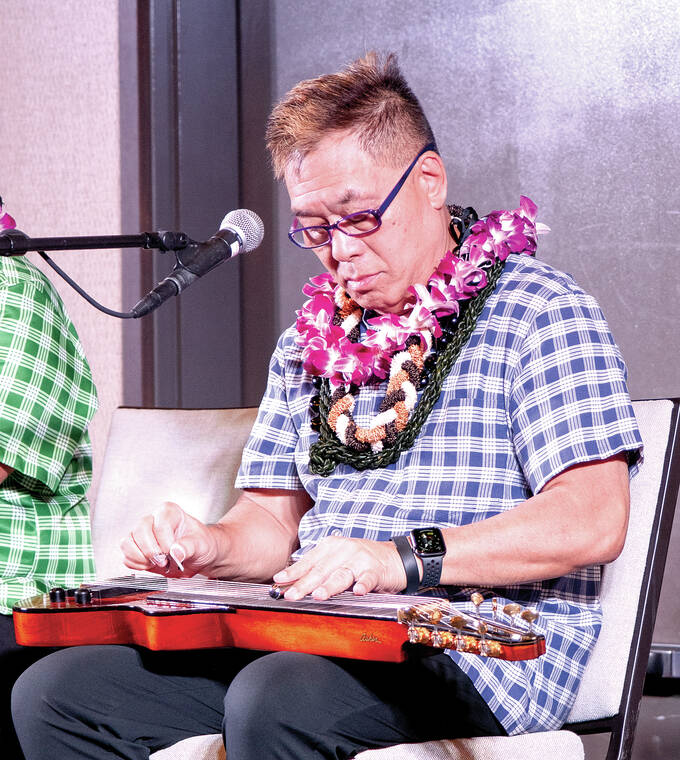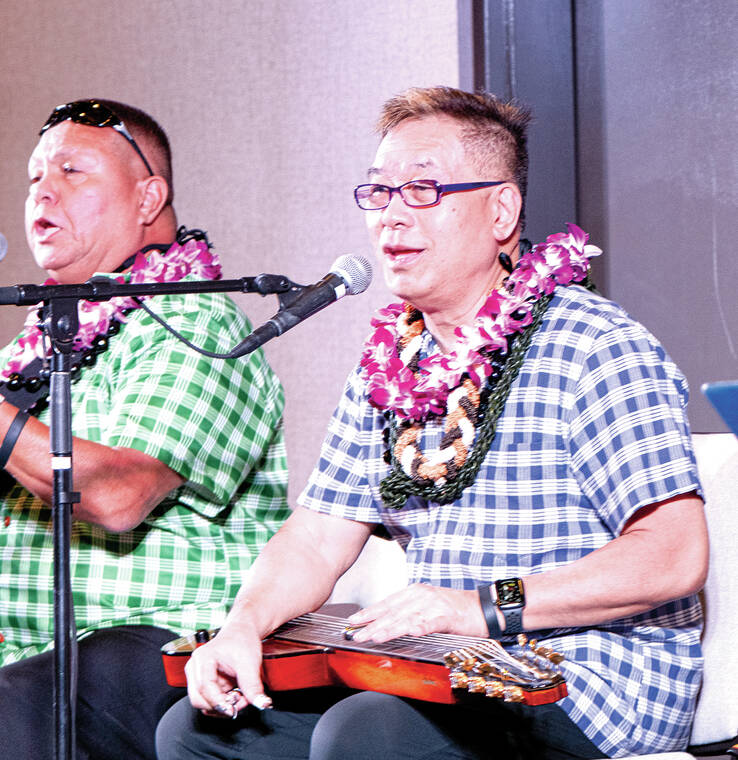The Hawaiian steel guitar changed American music. Can one man keep that tradition alive?
KAILUA — Quincy Cortez plucks at a slim black box laid across his legs, his fingers flashing silver.
Steel strings twang with each pull from the metal rings — wearable guitar picks — adorning his right thumb, index and middle finger. His left hand hovers over the strings along the neck, a cylindrical tube held between his thumb and middle finger drawing the metallic tones into a smooth glissando when it touches steel.
ADVERTISING
A few minutes into the leisurely melody, the 16-year-old hesitates.
Next to him, 67-year-old teacher and musician Alan Akaka swivels his desk chair from his computer screen to face Cortez with a pop quiz: “Have you been practicing with the music?”
Cortez lifts his hands from the strings. “Kind of,” he says. With school work and sports, sometimes it’s hard to find the time.
The Hawaiian steel guitar became a cultural force in America at the turn of the century, popularized by troupes of traveling musicians from Hawaii. It evolved beyond its association with a tropical paradise to influence new genres of music, from bluegrass to jazz to rock and roll. But while the steel guitar can still be found in country and other types of music, the Hawaiian steel guitar garners little recognition today, even on the island of Oahu, its birthplace.
That’s where students like Cortez come in. He’s a recruit, part of a new generation of players trained by Akaka, who is working to keep the practice alive and knows the clock is ticking.
•••
Akaka, who has been playing Hawaiian steel guitar for more than 50 years, was not initially drawn to the instrument, despite hearing it at parties and luaus while growing up. As an 8-year-old, he first taught himself how to play the ukulele that was stored under his father’s bed, but only when Daniel Kahikina Akaka, a U.S. senator and church choir director, wasn’t home. Then Akaka learned the clarinet for the school band.
It wasn’t until he was 14, hearing his older brother play Hawaiian music on his steel guitar at home, that Akaka’s interest in the gliding style was piqued.
After teaching himself how to play, he began teaching others — for $2 a lesson — while studying education at the University of Hawaii. He received his master’s degree in 1994 and opened his own school for Hawaiian music in 2009.
At first, most of his Hawaiian steel guitar students were adults, Akaka said. But he started taking on younger learners after he realized the musicians of his era were starting to fade.
“Some of my generation, they were playing in the clubs and that was all good,” he said. “But there were no young ones below us taking up the instrument.”
In the 1970s, the Hawaiian steel guitar was so popular in the U.S. that attendees of an annual festival in Indiana would fly in from as far as England and China and camp outside a motel when it ran out of rooms, said Mark Prucha, president of the Aloha International Steel Guitar Club.
At last year’s convention, there were fewer than 100 people.
“You have to put in a lot of effort in order to be able to sound good on it, to sound proficient,” the 30-year-old software engineer said. “But because of that it’s a more expressive instrument than any other. Do you slide into it, do you play staccato? It’s really what you do in between the notes too.”
By teaching younger students and encouraging them to perform, Akaka says he is “planting seeds.”
During Cortez’s lesson, his third, the teenager works through the song “Beyond the Reef” amid a cluster of guitars in Akaka’s home office. Cortez’s parents came up with the idea of steel guitar lessons, thinking they might improve his performance in his Hawaiian music ensemble, where he plays the ukulele.
Like Akaka, Cortez started playing ukulele at 8 and inherited a love of Hawaiian music from his family. But he is often busy with schoolwork and football practice, and the steel guitar is unlike any other instrument he’s encountered. So he struggles.
By the end of the hour, Akaka has pivoted to a new tack for his student. He pulls out a black-and-gold steel guitar, a six-string Supro donated by another musician to replace the basic model Cortez uses at home. Akaka has a feeling that it belongs with Cortez — with one condition.
“If I give this to you, will you practice?” he asks.
After a pause, Cortez answers: “Yes.”
•••
Nearly all the legends trace the invention of the Hawaiian steel guitar back to Joseph Kekuku in the 1880s.
In one retelling, the young teen was walking along railroad tracks in Oahu when he decided to run a stray bolt or spike along his guitar strings, eliciting a primitive version of what would later become a smooth signature slide. In others, he utilized a metal comb, or a penknife’s back, or a razor’s edge.
Whatever the initial spark, Kekuku refined and perfected the new technique, crafting a steel bar at his school’s machine shop to run over the neck of the guitar while his other hand plucked the strings. The lilting vibrato made a natural accompaniment to the laid-back melodies of Hawaiian songs.
“Up to this point, guitars themselves had not played a role as a lead instrument,” said John Troutman, a music historian and the author of “Kika Kila: How the Hawaiian Steel Guitar Changed the Sound of Modern Music.” “This all begins to change with the steel guitar.”
In 1893, a group of Americans overthrew the Hawaiian monarchy and instilled their own provisional government. As U.S. officials failed to restore the kingdom and ultimately annexed the island five years later, Native Hawaiian musicians began traversing the mainland for economic advancement and to spread stories of Hawaii’s plight.
By 1916, records of Hawaiian steel guitar were outselling every other music genre in the nation. Hawaiian music started cropping up in Hollywood soundtracks and L.A. clubs, and was further entrenched in the culture by the Broadway production “Bird of Paradise,” and the radio program “Hawaii Calls.” Soon its popularity and influence were spreading globally as well.
According to Troutman, stores in London started stocking steel guitars in the early 1920s. By the 1940s, people were packing into Shanghai clubs to hear the Hawaiian steel guitar. Indian musicians began adapting their own classical music for steel guitar, and in Africa, the quest to replicate the glissando effect begat a local technique dubbed “Hauyani” after the word “Hawaiian.”
The Hawaiian craze produced a wave of eager young learners in the U.S. One Cleveland-based enterprise, the Oahu Publishing Company, founded in 1926, sent salesmen door to door, promising families a free guitar for every child that completed a year’s worth of lessons. It became known as the “Amway of Hawaiian guitar,” encouraging its 200,000-some alumni to buy studios and sell materials themselves.
That was how Joanne Parker and Janis Crum first learned the guitar while growing up on a dairy farm in Eaton Rapids, Mich.
“We were very excited about it,” Crum said. “Those days you would allow a stranger to stand at your door and talk. Nowadays, you would think twice.”
After graduating from high school in 1948, the twins began traveling around the country as the Williams Sisters, playing Hawaiian steel guitar at three to four school assemblies a day and conventions for adults. Now 93, they still play together every week, though their listeners have changed.
“We do a lot of entertaining now, but our audiences are retirement centers,” said Crum.
The golden era for Hawaiian steel guitar was eventually trumped by the popularization of the electric guitar — born out of efforts to amplify the Hawaiian instrument — which became a cornerstone of rock and roll, enrapturing the next generation of music lovers.
The addition of pedals made steel guitar a country music staple, while blues and jazz musicians adopted the slide guitar, which utilized a similar gliding technique while holding the guitar upright. Meanwhile, the quintessential Hawaiian sound was losing appeal at home.
By the 2000s, Hawaiian music fans had started a letter-writing campaign to the high-rise hotels along Waikiki Beach, asking them to bring back the traditional island melodies, said Bill Wynne, 53, who grew up listening to his father play steel guitar in New Jersey.
The hotels responded by saying their guests would rather hear other kinds of music instead.
“If you walk the streets of Waikiki now, you’ll hear jazz bands, you’ll hear piano lounges, you will hear reggae and salsa bands,” said Wynne. “You will not hear a shred of Hawaiian music.”
•••
Sitting in front of his computer, Akaka tilts his video camera down onto his lap, to show how his fingers move along the guitar. Some of his students, joining virtually, are similarly positioned. Others have their cameras turned off, their mics muted.
“Leilani, how are you doing with this song?” he asks an attendee from Orlando.
“I’m still struggling,” she admits. “It’s not smooth.”
“For me, teaching is like a responsibility… and I want to help to bring it back,” Akaka says. “I feel it was passed on to me, by everybody else I used to play with.”
Looking through photographs at his desk, he marvels at the older generations, and the new.
“I used to play with a lot of old-timers. I was always the baby in the group,” he says, pointing out where he stood, still black-haired, next to the legends of his day. “A lot of these guys are gone now.”
When Daniel Tremblay, 73, approached Akaka for instruction eight years ago, he said Akaka was hesitant to divert his attention from his younger students. But the retired lawyer was persistent.
Now Tremblay has joined Akaka on his mission, offering free lessons for beginners Thursday afternoons at the Hyatt Regency on Waikiki Beach.
“You’ve gotta get the kids to put down their devices and pick up a guitar,” said Tremblay, who added that while can’t play like Akaka, he hopes to inspire the next young learner who can.
Akaka doesn’t have exact numbers on how many players his school has trained, or any other metrics that can definitively prove that the instrument is on the upswing. But he is encouraged by small signs that appreciation for Hawaiian steel is slowly returning. He cites the return of the instrument in Waikiki and in hula competitions, and rising prices for vintage steel guitars.
Kilin Reece, who founded the Hawaiian music nonprofit Kealaki Center for Pacific Strings in 2019, said a renewed interest in Native languages and culture has enabled grant funding for projects that feature the Hawaiian steel guitar, including an online museum and a pilot program to make lap steel guitars out of invasive tree species in Hawaii.
“There is a great renaissance happening right now in Hawaiian musical arts,” Reece said.
Many of Akaka’s next-gen students are now grown, though he still remembers when some of them were dwarfed by their instruments and their feet dangled off their chairs during their first performances.
When Malie Lyman first started studying with Akaka at age 8, he considered her to be the youngest Hawaiian steel guitar player in the world. Now 20, she is one of the best-known Hawaiian musicians of her generation, traversing Hawaii and the West Coast, playing professionally.
“Steel guitar isn’t the rhythm, it isn’t the heartbeat, it’s the cherry on the top,” Lyman said. “It’s kind of like the glitter to the song.”
She hopes to teach her own children how to play someday, to preserve its importance in her Native culture.
“I’m trying my best to keep it known, and I think I’m doing a good job,” Lyman added. “As long as its being played, it’s doing OK.”



